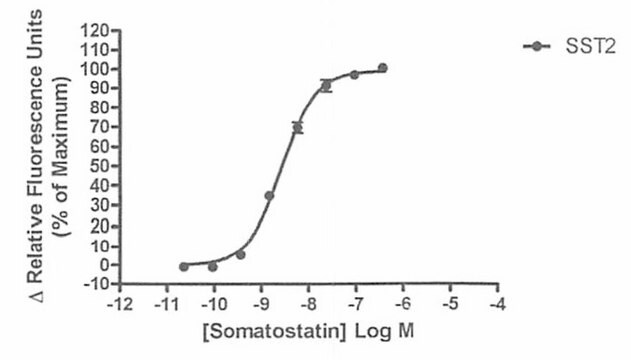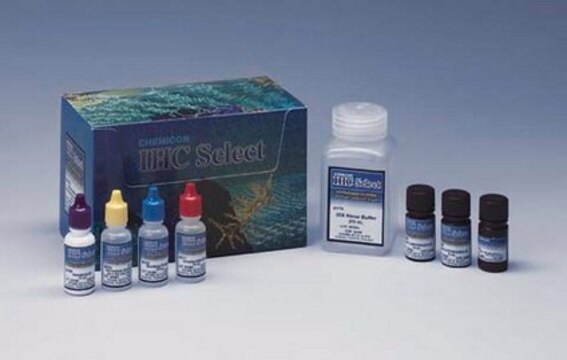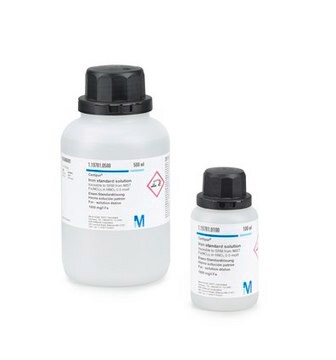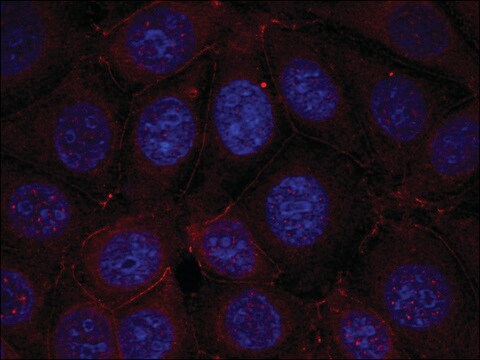HTS171RTA
Ready-to-Assay sst 3 Somatostatin Family Receptor Frozen Cells
Sign Into View Organizational & Contract Pricing
All Photos(1)
About This Item
UNSPSC Code:
41106514
eCl@ss:
32011203
Recommended Products
biological source
human
Quality Level
manufacturer/tradename
Ready-to-Assay
technique(s)
calcium flux assay: suitable
NCBI accession no.
detection method
fluorometric
General description
Millipore′s Ready-to-Assay GPCR frozen cells are designed for simple, rapid calcium assays with no requirement for intensive cell culturing. Millipore has optimized the freezing conditions to provide cells with high viability and functionality post-thaw. The user simply thaws the cells and resuspends them in media, dispenses cell suspension into assay plates and, following over night recovery, assays for calcium response.
Somatostatin is a 14 or 28 amino acid regulatory peptide that inhibits hormone secretion from the pituitary, pancreas, and other endocrine sites. A family of 6 GPCRs, sst1, sst2A, sst2B, sst3, sst4 and sst5, mediate the biological activity of somatostatins. The somatostatin receptors couple to Gi to inhibit cAMP production, and also increase MAP kinase signalling. Several tumors have been shown to overexpress somatostatin receptors, and binding of somatostatin to these tumor cells stimulates or inhibits proliferation, depending on the receptor subtypes expressed (Olias et al., 2004). However, sst3 appears to promote apoptosis, and expression of sst3 was found to be lower in gastric cancer cells than in normal gastric mucosa, in proportion to susceptibility to apoptosis induced by somatostatin analogs (Sharma et al., 1996; Hu et al., 2004). In addition, sst3 is expressed in smooth muscle cells and mediates gastrointestinal contractions. Millipore′s cloned human sst3-expressing cell line is made in the Chem-1 host, which supports high levels of recombinant sst3 expression on the cell surface and contains high levels of the promiscuous G protein Gα15 to couple the receptor to the calcium signaling pathway. Thus, the cell line is an ideal tool for screening for agonists, antagonists and modulators at sst3.
Somatostatin is a 14 or 28 amino acid regulatory peptide that inhibits hormone secretion from the pituitary, pancreas, and other endocrine sites. A family of 6 GPCRs, sst1, sst2A, sst2B, sst3, sst4 and sst5, mediate the biological activity of somatostatins. The somatostatin receptors couple to Gi to inhibit cAMP production, and also increase MAP kinase signalling. Several tumors have been shown to overexpress somatostatin receptors, and binding of somatostatin to these tumor cells stimulates or inhibits proliferation, depending on the receptor subtypes expressed (Olias et al., 2004). However, sst3 appears to promote apoptosis, and expression of sst3 was found to be lower in gastric cancer cells than in normal gastric mucosa, in proportion to susceptibility to apoptosis induced by somatostatin analogs (Sharma et al., 1996; Hu et al., 2004). In addition, sst3 is expressed in smooth muscle cells and mediates gastrointestinal contractions. Millipore′s cloned human sst3-expressing cell line is made in the Chem-1 host, which supports high levels of recombinant sst3 expression on the cell surface and contains high levels of the promiscuous G protein Gα15 to couple the receptor to the calcium signaling pathway. Thus, the cell line is an ideal tool for screening for agonists, antagonists and modulators at sst3.
Cell Line Description
- GPCR Cell Lines
- Host cells: Chem-1
Application
Human sst3 GPCR frozen cells for Calcium Flux FLIPR Assays.
Biochem/physiol Actions
- GPCR Class: A
- Protein Target: sst3
- Target Sub-Family: Somatostatin
Components
Pack contains 2 vials of mycoplasma-free cells, 1 ml per vial. Fifty (50) mL of Media Component.
Disclaimer
This product contains genetically modified organisms (GMO).
Within the EU GMOs are regulated by Directives 2001/18/EC and 2009/41/EC of the European Parliament and of the Council and their national implementation in the member States respectively.
Storage Class Code
6.2 - Infectious substances
WGK
WGK 1
Flash Point(F)
Not applicable
Flash Point(C)
Not applicable
Certificates of Analysis (COA)
Search for Certificates of Analysis (COA) by entering the products Lot/Batch Number. Lot and Batch Numbers can be found on a product’s label following the words ‘Lot’ or ‘Batch’.
Already Own This Product?
Find documentation for the products that you have recently purchased in the Document Library.
Our team of scientists has experience in all areas of research including Life Science, Material Science, Chemical Synthesis, Chromatography, Analytical and many others.
Contact Technical Service








